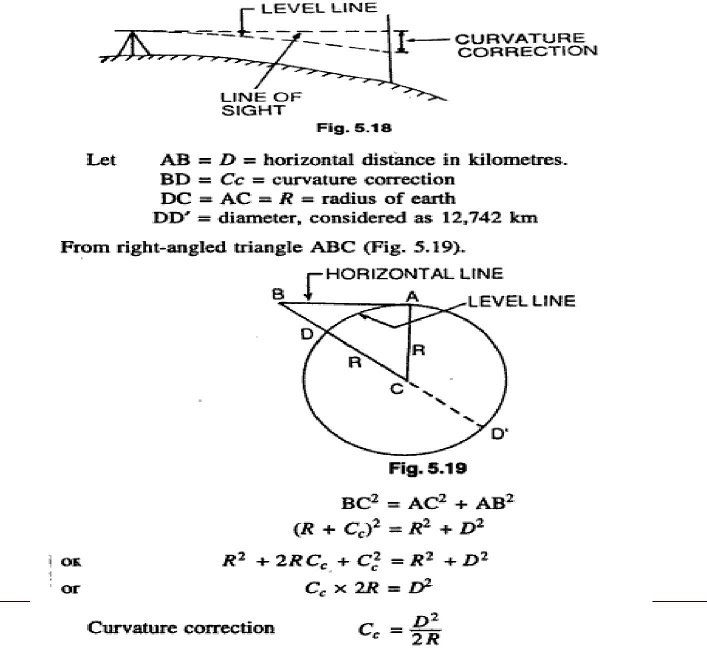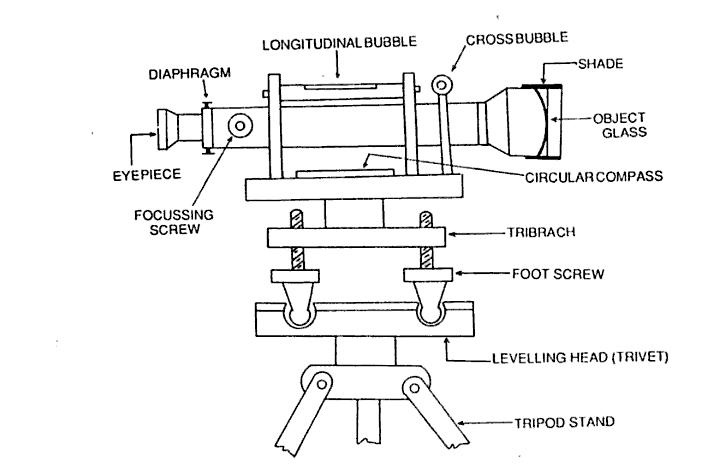Chapter: Civil Surveying : Compass and Plane Table Surveying
Different types of levels ( Levelling Instrument)

Different
types of levels ( Levelling Instrument) with neat sketches
Dumpy
Level, Wye Level, Reversible Level, Tilting Level, and Digital level
1.
Dumpy level:
A
schematic diagram of an engineer's level is shown in. An engineer's level
primarily consists of a telescope mounted upon a level bar which is rigidly
fastened to the spindle. Inside the tube of the telescope, there are objective
and eye piece lens at the either end of the tube. A diaphragm fitted with cross
hairs is present near the eye piece end. A focussing screw is attached with the
telescope. A level tube housing a sensitive plate bubble is attached to the
telescope (or to the level bar) and parallel to it. The spindle fits into a
cone-shaped bearing of the leveling head. The leveling head consists of
tribrach and trivet with three foot screws known as leveling screws in between.
The trivet is attached to a tripod stand. It is simple compact and stable. The
telescope is rigidly fixed to its support therefore cannot be rotated about its
longitudinal axis. A long bubble tube is attached to the top of telescope.
Dumpy literally means short and thick.

Telescope : used to sight a staff placed at
desired station and to read staff reading distinctly.
Diaphragm : holds the cross hairs (fitted with it).
Eye piece : magnifies the image formed in the
plane of the diaphragm and thus to read staff during leveling.
Level Tube : used to make the axis of the
telescope horizontal and thus the line of sight.
Leveling screws : to adjust instrument (level) so that
the line of sight is horizontal for any orientation of the telescope.
Tripod stand : to fix the instrument (level) at a convenient height of an
observer.
2. Wye level:
The essential difference between the
dumpy level and the Wye level is that in the former case the telescope is fixed
to the spindle while in the Wye level, the telescope is carried in two vertical
Wye supports. The Wye support consists of curved clips.The clips are raised,
the telescope can be rotated in the Wyes, or removed and turned end for end. When
the clips are fastened the telescope is held from turning about its axis by a
lug on one of the clips. The bubble tube may be attached either to the
telescope or to the stage carrying the wyes.
3. Reversible level:
A reversible level combines the
features of bioth the dumpy level and the Wye level. The telescope is supported
by two rigid sockets into which the telescope can be introduced from either end
and then fixed in position by a screw. The sockets are rigidly connected to the
spindle through a stage.
4. Tilting level :
It consists of a telescope attached
with a level tube which can be tilted within few degrees in vertical plane by a
tilting screw.
The main peculiarity of this level is
that the vertical axis need not be truly vertical, since the line of
collimation is not perpendicular to it. The line of collimation, is, however,
made horizontal for each pointing of telescope by means of tilting screw. It is
mainly designed for precise leveling work.
5. Digital level
There are fundamentally two types of automatic levels.
First, the optical one whose
distinguishing feature is self-leveling i.e., the instruments gets
approximately leveled by means of a circular spirit level and then it maintains
a horizontal line of sight of its own.
Second, the digital levels whose
distinguishing features are automatic leveling, reading and recording.
Related Topics